Fraction to Decimal
In this section, we will learn how to convert fraction to decimal. Before proceeding to conversion, let’s have a quick look at the fraction and decimal.
Fraction
A fraction represents the decimal number in the form of numerator and denominator, i.e.
- Improper Fraction
- Mixed Fraction
Improper Fraction
A fraction is a number that is in the form of 

Mixed Fraction
A mixed fraction is a number that is in the form of a

- Multiply the whole number (a) by the denominator (c). We get (a×c) as a result.
- In the above result (a×c), add the numerator (b). After adding the numerator, we get the numerator of the improper fraction.
- The denominator of the improper fraction will be the denominator of the mixed fraction.
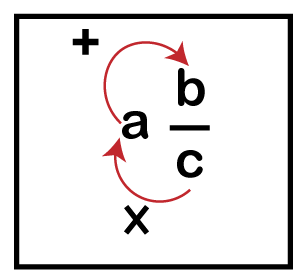
In general, we can say that:

Decimal
A decimal number is a number that has a decimal point (.). The decimal part separates the whole number and decimal part. It is another way to represent a fraction. It is not a whole number. For example, 22.96, 1.657, 987.09877, etc.
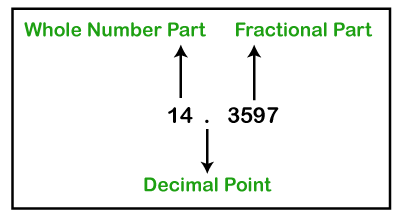
If a decimal number has any number of zeros after the decimal point, consider it as a whole number. Because zeros after decimal point do not affect the value. For example, 56.0000 is the same as 56. But 56.00001 is not the same as 56.
Let’s have a look at the following decimal place value chart.

In the above table, we have observed that when we move to the left of the decimal point, the values get ten times larger, and moving to the right of the decimal point, the values get ten times smaller.
Let’s take a decimal number and understand what does it mean.
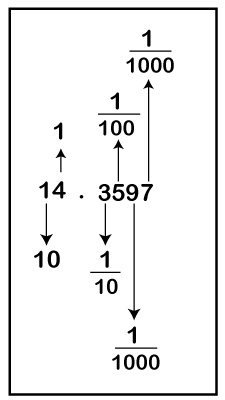
Fraction to Decimal Conversion
There are three methods to convert the fraction to decimal.
- Using Calculator
- Expand Denominator Method
- Long Division Method
Using Calculator
It is the easiest method to convert the fraction to decimal. Divide the numerator by the denominator and get the answer in decimal.
Example 1: Change the fraction
Solution:
In the calculator, press the 9, /, and 7 keys, respectively. After that, press the equal button to get the answer.
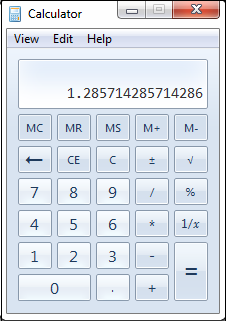
Expand Denominator Method
Step 1: Find the number that can convert the denominator to the power of 10. It means a number that can convert a denominator to 10, 100, or 1000. In short, 1 followed by 0s.
Step 2: Multiply the numerator and the denominator by the same number that we get above.
Step 3: Count the 0s in the denominator and put a decimal point in the numerator after the same digits from the right side.
Let’s understand it through examples.
Example 2: What will be the value of
Solution:
In the given fraction, 9 is the numerator, and 5 is the denominator.
Step 1: We can convert the denominator to the power of 10 by multiplying it by 2.

Step 3: The denominator has only one 0, so we will put a decimal point in the numerator after counting the one digit from the right. That is 1.8.
Hence, the fraction
Example 3: Find the value of
Solution:
In the given fraction, 35 is the numerator, and 4 is the denominator.
Step 1: We can convert the denominator to the power of 10 by multiplying it by 25.

Step 3: The denominator has two 0s, so we will put a decimal point in the numerator after counting the two digits from the right. That is 8.75.
Hence, the fraction
Example 4: Find the decimal value of
Solution:
In the given fraction, 99 is the numerator, and 8 is the denominator.
Step 1: We can convert the denominator to the power of 10 by multiplying it by 125.

Step 3: The denominator has three 0s, so we will put a decimal point in the numerator after counting the three digits from the right. That is 12.375.
Hence, the fraction
Example 5: Find the value of
Solution:
In the given fraction, 225 is the numerator, and 16 is the denominator.
Step 1: We can convert the denominator to the power of 10 by multiplying it by 625.

Step 3: The denominator has four 0s, so we will put a decimal point in the numerator after counting the four digits from the right. That is 14.0625.
Hence, the fraction
Long Division Method
It is another method to convert the fraction to decimal. It is the same as we divide two numbers, but it a little bit tricky due to the increment of 0s. We can use this method to find the answer to a number of decimal places.
Example 6: Find the value of
Solution:
Step 1: 5 goes into 8 because 1 time 5 is 5. On subtracting 5 from 8, we get 3 as the remainder.

Step 2: 5 is too big to divide into 3, so the only way we can get rid of the remainder is to use a 0 in the tenths place that makes the number we are dividing up kind of look like 80. Now we can bring down that extra 0 to make the remainder look like 30.

Step 3: 5 goes into 30 six times because 5 times six equals to 30, and leaves no remainder.
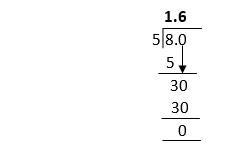
Hence, the fraction
Example 7: What will be the value of
Solution:
4 is too big to go into 3.
Step 1: Let’s put a decimal point after the 3, and a zero in the tenths place to make it 3.0. Now it is similar to 30 divides by 4.

Step 2: 4 goes into 30 because 7 times 4 is 28. On subtracting 28 from 30, we get 2 as remainder.

Step 3: 4 is too big to divide into 2, so the only way we can get rid of the remainder is to use another 0 in the hundredths place that makes the number we are dividing up kind of look like 300. Now we can bring down that extra 0 to make the remainder look like 20.

Step 4: 4 goes into 20 five times because five times four equals to 20, and leaves no remainder.

Step 5: Include a decimal point in the answer. If you kept your column lined up as we have done, you would see that the decimal point goes right here. It makes our answer 0.75.

Hence, the fraction
Example 8: Change the fraction
Solution:

Hence, the fraction
Example 9: Find the value of
Solution:

In the above example, we have seen that it leaves remainder 1 again and again. It looks like it might keep on going forever. So, some fractions may be of this type. If we divide them, we see a repeating pattern of numbers that are continuously going on.
So, the decimal value of 
Another way to represent the repeating number is to use a bar above the repeating number, as we have shown below.

Hence, the fraction 
